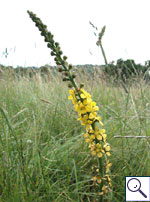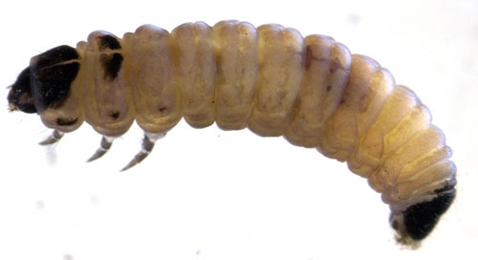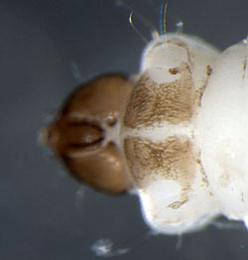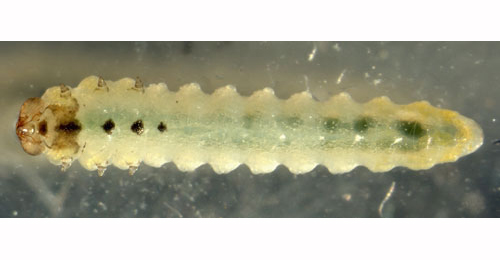 |
| |
(Coleoptera, Diptera, Hymenoptera and Lepidoptera)
by
Brian Pitkin, Willem Ellis, Colin Plant and Rob Edmunds
|
|
|
|
AGRIMONIA.
Agrimony. [Rosaceae]
|
|
Two
species of Agrimonia are recorded in Britain, the native
Agrimony (A. eupatoria L.) and Fragrant Agrimony (A. procera
Wallr.). The BSBI provide a downloadable plant crib for Agrimonia.
Fifteen British miners are recorded on Agrimonia.
A key to the European miners recorded on Agrimonia is provided in Bladmineerders van Europa.
|

Fragrant
agrimony
Agrimonia procera
|
Key for the identification of the known mines of British
Diptera recorded on Agrimonia
|
Note: Diptera larvae may live in a corridor mine, a corridor-blotch mine, or a blotch mine, but never in a case, a rolled or folded leaf, a tentiform mine or sandwiched between two more or less circular leaf sections in later instars. Pupation never in a cocoon. All mining Diptera larvae are leg-less maggots without a head capsule (see examples). They never have thoracic or abdominal legs. They do not have chewing mouthparts, although they do have a characteristic cephalo-pharyngeal skeleton (see examples), usually visible internally through the body wall. The larvae lie on their sides within the mine and use their pick-like mouthparts to feed on plant tissue. In some corridor miners frass may lie in two rows on alternate sides of the mine. In order to vacate the mine the fully grown larva cuts an exit slit, which is usually semi-circular (see Liriomyza huidobrensis video). The pupa is formed within the hardened last larval skin or puparium and as a result sheaths enclosing head appendages, wings and legs are not visible externally (see examples).
See Key to non-Diptera.
|
1a > Leaf-miner: Initially
a linear mine which later develops into a conspicuous blotch; frass
in two rows in linear section, scattered irregularly in the blotch
(Spencer, 1976: 134-5, fig.
237, as potentillae).
Corridor,
gradually and considerably widening towards the end. Frass in two
rows in the corridor part, further up dispersed irregularly. Pupation
outside the mine.
A short broad upper surface corridor leading to a long blotch between veins. |
|
|
On Agrimonia, Filipendula, Fragaria, Geum, Potentilla, Rubus and Sanguisorba in Britain. On additional Rosaceae elsewhere.
Common and widespread throughout Britain. Also recorded in the
Republic of Ireland, Europe, Japan, U.S.A. and Canada.
|
Agromyza idaeiana (Hardy, 1853) [Diptera: Agromyzidae]. |
1b > Leaf-miner: A
long linear mine, never widening into a blotch at end (Spencer,
1976: 107-8, fig. 167).
Long
upper-surface corridor. Many straight stretches, often along the
midrib. Frass in discrete grains, here and there in thread fragments,
but never in pearl strings. Pupation outside the mine.
A long straight mine, which is sometimes branched. Found in the upper leaf surface. |
|
On Filipendula, Potentilla, Rubus and Sanguisorba, but not yet on Agrimonia, in
Britain and Filipendula, Potentilla, Rubus and Sanguisorba elsewhere. Currently
known in Britain only from Warwick and Mid-west York. Also recorded
in the Republic of Ireland and continental Europe.
|
Agromyza
filipendulae Spencer, 1976 [Diptera: Agromyzidae]. |
1c > Leaf-miner: A distinctive mine primarily above mid-rib, with irregular short
lateral offshoots into leaf blade. Pupation external (Spencer, 1972:
51 (fig. 172), 55; Spencer, 1976:
270, 271 (fig. 486)).
Branched,
whitish, upper-surface corridor; main axis overlying the midrib;
side branches overlying the main lateral veins. (In Campanula and Phyteuma the mine is much less branched, sometimes nothing
more than a corridor on top of the midrib). Frass in rather long
strings. Usually the mines begins as a long and narrow, shallow,
tortuous lower-surface corridor that ends upon the midrib but otherwise
is not associated with the leaf venation. Often this initial corridor
is filled with callus, and then even less conspicuous. Pupation
outside the mine.
A
linear mine on the upper surface, usually following the midrib and
showing side branches along the veins. The frass is in strings. |
|

Liriomyza strigata larva, lateral
Image: © Willem Ellis (Bladmineerders van Europa)
|
Polyphagous. On more than 40 host genera in 15 families, but not yet on Agrimonia, in Britain. On Agrimonia elsewhere. Widespread
throughout Britain. Also recorded in the Republic of Ireland. Widespread in continental Europe.
|
Liriomyza
strigata (Meigen, 1830) [Diptera: Agromyzidae]. |
|
Key for the identification of the known mines of British
non-Diptera recorded on
Agrimonia
|
Note: The larvae of mining Coleoptera, Hymenoptera and Lepidoptera may live in a corridor mine, a corridor-blotch mine, a blotch mine, a case, a rolled or folded leaf, a tentiform mine or sandwiched between two more or less circular leaf sections in later instars. Larva may pupate in a silk cocoon. The larva may have six legs (although they may be reduced or absent), a head capsule and chewing mouthparts with opposable mandibles (see video of a gracillarid larva feeding). Larvae of Hymenoptera and Lepidoptera usually also have abdominal legs (see examples). Frass, if present, never in two rows. Unless feeding externally from within a case the larva usually vacates the mine by chewing an exit hole. Pupa with visible head appendages, wings and legs which lie in sheaths (see examples).
|
1a > Miner and case-bearer. The larva lives outside the mine, protected by a case, and feeds on the underlying plant tissues via a hole cut in the epidermis. Mine does not contain frass - Coleophora species |
2 |
1b > Leaf-miner, but not a case-bearer: The larva lives mainly inside the mine. Mine usually contains frass. In later instars the larva may live sandwiched between two more or less circular sections cut from the leaf. |
3 |
2a > Leaf-miner
and case-bearer: In addition to the small hole where the case was attached there is often a larger hole where the larva has cut a piece of leaf epidermis to create its case. No frass in mine.
The case resembles that of C.
violacea, but does not lie so flat again the leaf as this
species (having a mouth angle of 30 to 50°). C.
violacea also has a case which bulges in the middle, whereas
in C. potentillae the case tapers towards the posterior.
Immediately
after emergence the larva makes a full depth, quickly widening,
corridor, with frass as small grains in a broad central band. Finally
results a blotch of 2 x 5 mm, from which the youth case is cut.
The fully developed case is a hairy, greyish brown to silver grey
lobe case of about 1 cm long, with a clearly laterally compressed
end; the mouth angle is about 90°. The case is difficult to
separate from that of C. ochripennella. |
|
|
On Agrimonia, Betula, Crataegus, Filipendula ulmaria, Fragaria
vesca, Geum, Helianthemum nummularium,
Potentilla, Prunus spinosa, Rosa, Rubus caesius, Rosa fruticosus and Salix cinerea in Britain plus Malus sylvestris,
Ribes, Sanguisorba and Spiraea elsewhere. Widespread
in Britain and in continental Europe.
|
Coleophora
potentillae (Elisha, 1885) [Lepidoptera: Coleophoridae]. |
2b > Leaf-miner
and case-bearer: In addition to the small hole where the case was attached there is often a larger hole where the larva has cut a piece of leaf epidermis to create its case. No frass in mine.
The larva feeds on a wide range of trees, shrubs and herbs, favouring
Rosaceae, but not exclusively. The fully developed cased larva may
be found active in October and again, after winter diapause, in
April. Cases, about 6 mm, of diapausing larvae may be found through
winter, fixed to a tree or fence post. The dorsal surface of the
case is usually covered in leaf fragments, but they can sometimes
be worn off almost smooth. The ventral surface is swollen at the
middle and has a keel, which usually bends upwards at the posterior.
The cases of C. ahenella (on Rhamnus, Frangula, Viburnum and Cornus) and C.
potentillae (case less swollen, keel not bent up, resting
position less prone) are very similar.
Brownish
lobe case that lies almost flat on the leaf, either on the upper
or on the lower side. Case widest about the middle. Ventrally there
is a distinct keel. Mouth angle 0°. Full depth mines rather
large. The flaps of cuticular tissue that serve to enlarge the case
are cut out of the upper epidermis. (contrary to C.
ahenella and C.
potentillae, that use tissue from the lower epidermis).
The removal of these tissue flaps creates holes that are much larger
than those that serve as the entrance to the mine. |
|

Coleophora violacea larva, lateral
Image: © Willem Ellis (Bladmineerders van Europa) |
Polyphagous. On numerous genera and species in several plant families, including Agrimonia, in Britain and elsewhere. Widespread in Britain
and continental Europe.
|
Coleophora
violaceae (Ström, 1783) [Lepidoptera: Coleophoridae]. |
3a > Leaf-miner: A long usually narrow winding corridor mine with a central line of frass. Larva not living in a rolled or folded leaf, a tentiform mine or sandwiched between two more or less circular leaf sections in later instars |
4 |
3b > Leaf-miner: Either a blotch or short corridor which becomes a blotch. Larva may live in a rolled or folded leaf, a tentiform mine or sandwiched between two more or less circular leaf sections in later instars |
5 |
4a > Leaf-miner: A slender gallery, leading to blotch. Larva is a pale watery greenish
yellowish (whereas S.
poterii its yellow).
Egg
some place at the underside of the leaf. The first part of the mine
is a long, slender corridor, rather straight, often folllowing a
vein or the leaf margin. The frass here is black, lying in a very
narrow central line. The corridor abruptly widens into a large blotch,
where the the frass lies irregularly scattered. |
|
On Agrimonia, Fragaria and Potentilla in Britain
and elsewhere. Widespread in Britain and continental Europe.
|
Stigmella
aeneofasciella (Herrich-Schäffer, 1855) [Lepidoptera:
Nepticulidae]. |
4b > Leaf-miner: A long gallery with dispersed frass. Oviposition
may be at either side of the leaf, not necessarily close to a vein.
The mine is a not very tortuous corridor, not widened in the end.
Frass in a broad central line. The mine strongly overlaps with the
one of S. splendidissimella. |
|
|
On Agrimonia, Fragaria, Geum, Potentilla and Rubus in Britain plus Geranium elsewhere. Widespread in Britain
and continental Europe.
|
Stigmella
aurella (Fabricius, 1775) [Lepidoptera: Nepticulidae]. |
| 4c > Leaf-miner: Egg
on the leaf upperside. The mine is an unusually short, not very
tortuous corridor with a central line of frass that is irregularly
interrupted and takes about 2/3 of the corridor width. Pupation
external. |
On Rubus fruticosus but not yet on Agromonia in Britain; Agrimonia, Rubus
sanctus and Rubus ulmifolius elsewhere. England including
Dorset and South Wilts in Britain. Also recorded in the Republic
of Ireland and continental Europe.
|
Stigmella
auromarginella (Richardson, 1890) [Lepidoptera: Nepticulidae]. |
4d > Leaf-miner: A long sinuous gallery with narrow frass-line.
Oviposition
generally at the leaf upper side, not especially close to a vein.
From there a long and slender corridor starts, with frass usually
in a narrow central line. The corridor often crosses itself, but
rarely a thick vein (Blladmineerders van Europa). |
|
|
On Agrimonia, Filipendula, Fragaria, Geum, Potentilla and Rubus in Britain and elsewhere. Widespread in Britain,
Ireland and continental Europe.
|
Stigmella
splendidissimella (Herrich-Schäffer, 1855) [Lepidoptera:
Nepticulidae]. |
4e > Leaf-miner: The initial gallery is twisted and can follow the leaf edge. It
contains broken linear frass. it then widens to form a blotch or
gallery, with scattered frass.
Oviposition
on the leaf underside. There starts an initially strongly contorted
narrow corridor with a linear interrupted frass line. This is continued
in broad corridor or elongated blotch with dispersed frass. Often
a number of mines in a leaf. Pupation inside the mine, in a violet
to blackish cocoon. |
|
On Agrimonia eupatoria in Britain and Agrimonia eupatoria
and Aremonia agrimonioides elsewhere. Recorded in south-east
England. Widespread in continental Europe.
|
Ectoedemia
agrimoniae (Frey, 1858) [Lepidoptera: Nepticulidae]. |
4f > Leaf-miner: A gallery with dispersed frass.
Egg
at the underside of the leaf. The first part of the mine is a quite
narrow and strongly contorted gallery with grey brown frass. This
is followed by an elongate blotch (or broad corridor) that frequently
overlaps a part of the earlier mine; here the frass lies scattered
throughout the blotch. Pupation external. |
|
On Fragaria and Potentilla sterilis, but not
yet on Agrimonia, in Britain plus Agrimonia and Fragaria moschata, Fragaria vesca, Fragaria viridis and Potentilla erecta elsewhere. Widespread in Britain
and continental Europe.
|
Ectoedemia
arcuatella (Herrich-Schäffer, 1855) [Lepidoptera: Nepticulidae]. |
5a > Leaf-miner: Egg well visible, on the upper surface (contrary to Metallus
pumilus). The mine is a large, transparant, upper-surface
blotch, yellowish green at first, brownish later. Silk is deposited
in the mine, but the quantity is too little to influence its colour;
also the mine does not contract, like in C.
marginea. All frass is ejected through a small opening in
the underside of the mine. Pupation takes place after hibernation,
within the mine; pupa not in a cocoon. |
|

Coptotriche heinemanni larva, dorsal
Image: © Willem Ellis (Bladmineerders van Europa) |
|
On Rubus fruticosus, but not yet on Agrimonia, in Britain plus Agrimonia eupatoria,
Agrimonia procera, Rubus caesius, Rubus idaeus and Rubus
laciniatus elsewhere. Distribution in Britain unknown. Widespread
in continental Europe.
|
Coptotriche
heinemanni (Wocke, 1871) [Lepidoptera: Tischeriidae]. |
5b > Leaf-miner: Small
(less than 1 cm), full depth blotch, transparent when fresh, starting
at the leaf margin, usually near the leaf tip; frass in scattered
grains. The larva makes an elliptic double sided excision to form
a case. Subsequently, it continues feeding from within the case. |
|
|
On Agrimonia, Alchemilla, Filipendula, Fragaria, Geum and Rubus in Britain. On Achillea,
Agrimonia, Alchemilla, Filipendula, Fragaria, Geum, Potentilla, Rubus and Spiraea elsewhere.
Distributed throughout much of Britain. Widespread in continental
Europe.
|
Incurvaria
praelatella (Denis & Schiffermüller, 1775) [Lepidoptera:
Incurvariidae]. |
5c > Leaf-miner: Full depth transparent blotch without a clear preceding
corridor, quickly and strongly widening from the start. Frass in
sausage-shaped granules. Often several leaflets of a composite leaf
each have a mine.
The larvae of sawflies have at least six thoracic legs (although they may be reduced or absent), a head capsule and chewing mouthparts with opposable mandibles but no abdominal legs. |
|

Fenella nigrita larva
Image: © Willem Ellis (Bladmineerders van Europa) |
On Agrimonia, Potentilla and Rubus in Britain plus Aremonia, Filipendula, and Fragaria elsewhere. Widespread
in Britain including Surrey and West Cornwall. Widespread in continental
Europe.
|
Fenella
nigrita Westwood, 1839 [Hymenoptera: Tenthredinidae]. |
5d > Leaf-miner: In the first instar the larva mines the leaves, forming short,
irregular, blotch-like mines, but in later instars it lives externally,
feeding in spun leaves and often twisting those of tender shoots. Larval head light-brown or yellowish brown, edged with black postero-laterally,
ocellar area blackish; prothoracic plate black edged with whitish
anteriorly; abdomen dull dark green; pinacula distinct, black,
sometimes brownish but with black bases to setae; anal plate large,
black (Bradley et al., 1973).
Small,
full depth mine without a definite shape; little frass. Some silk
is deposited in the mine. The larva soon leaves the mine and continues
feeding among spun leaves. |
Polyphagous. On numerous genera and species of several plant families, but not yet on Agrimonia, in Britain and elsewhere. Widespread in
Britain and continental Europe. Also recorded from the Channel
Is.
|
Cnephasia
incertana (Treitschke, 1835) [Lepidoptera: Tortricidae]. |
|
|





